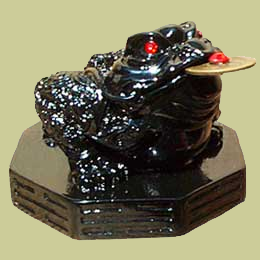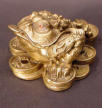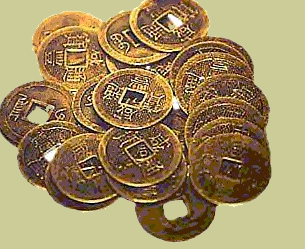|
|
|
||
Ch’an Chu: The Lucky Money Toad Amy Horwitz, Dan Learned, Ivan Ortiz, Lisa Dooley, Alexandria Ostowari
|
 |
|||
Ch’an Chu, the money frog, can be found sitting either on a haphazard pile of coins, egg shaped ingots, or a bagua, the mirror of Feng-Shui. A vital part to the ancient Chinese mysticism is “Feng-Shui, ‘the art of adapting the residence of the living and the dead so as to cooperate and harmonize with the local currents of the cosmic breath (the yin and yang)” (Werner, 54). Broadly, it is the art of placement so that Chi, or energy, obtains its optimal flow, so as to achieve that balance of harmony. Ch’an Chu is perched atop the mass ready to pounce at anyone brave enough to consider stealing. His flared nostrils and red stone eyes present a menacing, almost evil look. Scaly arms lead to a neck-less head and a smooth fat belly. Out the corners of his mouth and draped over his shoulders lay tasseled strings tethered with more square notched coins. The string in his mouth keeps it open just enough to clasp a coin whose center is filled with the same red stone of his eyes. The coin in his mouth differs from the others by being engraved with a dragon and a long slender bird instead of written symbols. Etched onto the crown of his head is the circular symbol of the yin and yang. Looking down his back, one sees seven clear stones connected by a clear line, which turn them into the constellation of the little dipper. At the end of his back is his third foot, which looks distinctly left, having a knee joint that juts out to that side. The ancient round I-Ching coins have square notches cut out of the centers, ranging in size from dimes to larger than quarters. A Chinese character fits along each side of the missing square. Feng-Shui experts claim that the “ancient Chinese coins have been used for centuries as amulets to ward of evil and disease” (Anjian Australia). The coins support the frog while at the same time becoming his possession. His front claws with four talons each grasp ingots that were originally gold. The golden ingots “take a simple boat-shape that symbolizes abundance and represents an easy life” (Feng Shui International). Other ingots of varying size are scattered throughout the pile. He also sits upon a Bagwa, made of eight sacred emblems called trigrams. It is used to encourage the flow of Chi (life force), which is regarded as the primary building brick of the universe. “The Bagwa is said to have been born on the back of a creature that rose from the deep at the dawn of time. The secrets of the universe are believed to be contained within. The Bagwig can be used in Feng-Shui to balance and move Chi. Feng-Shui Masters consider the Bagwa to be of great importance in correcting Feng-Shui Predicaments by deflecting almost anything that creates negative Chi'”(Feng Shui International). The presence of the Bagwa thus changes the meaning of this particular Money Toad into one that protects wealth instead of attracting it. |
||||
| Throughout
our anthropological experience, we encountered many bumps in the road. For
example, it was not clear at first exactly which Asian culture used the
Money Toad. Originally it was believed to be Cambodian. With the aid of
some knowledgeable sources, it was clarified that the symbol was Chinese.
This prompted further effort on behalf of our researcher, who spent hours
attempting to locate something substantial on Chan Chu, the toad god. However,
the databases provided by the library were of no use. This led her to ask
some Asian acquaintances, but, much like everyone else that had been asked,
they knew nothing about it other than that it was something that brought
luck. We then turned to one of our interviewers, who found quite a bit of
information. In Chinatown shops, predominately owned by Vietnamese, there are more frogs for sale than in use. Our first stop showed the slimmest of pickings having only one frog that was slightly banged up. The owner informed us that she did not own one herself because it was a Chinese tradition and she was Vietnamese. She suggested that we try the local bookstore and pointed us in that direction. Our second stop proved to be the jackpot in terms of frogs for sale. Like many other shops, it had rows of frogs ranging in size from a small key chain to a small child. The frogs for sale come in a spectrum of colors including jade green, lavender, red, gold and multi-colored. Additionally, the stones on the back forming the little dipper came in many different hues. The variation of colors implies that the current manufactures make the frogs to fit the color themes of modern Chinese who wish to follow certain traditions. Most other stores stocked the same supply of frogs. One of the last stores we went to had a collection of arrangements that included several frogs on wooden pedestals. The frogs were arranged in pairs or groups facing a large gold ingot at the center of the stand. Out of the multitudes of stores that we visited, only three displayed frogs in use. The first frog we came across in use was perched high above the merchandise almost touching the ceiling. It faced the hidden cash register and looked out over the store. It was situated in such a way to imply protection rather than accumulation. When asked about it, the owner seemed reluctant to comment, merely repeating “good luck.” The second frog in use was situated at the bottom of a multi-level alter situated at the back corner of the store. It faced out towards the store and was accompanied by statues of Buddha. Strewn amongst the statuettes were ancient coins and other “fake” currencies. Incense burned on several levels of the alter and it was clearly dedicated to Chinese culture. Strands of the ancient coins were laid on the main level of the alter as well as taped to the door separating the store from the supply room. The third and final store prominently displayed their frog although we did not see it until they pointed it out to us. It sat on a glass display case and looked as if it were for sale as well. It faced the door expressing the owner’s wish to bring money from the outside in. The frog is seen as having the ability to cross barriers, which is part of the reason it is used to entice wealth into the space it occupies. |
||||
 |
||||
 |
||||
During our research efforts, we found one myth that gave tremendous insight
about the statue. However, to first describe the meaning of the symbol,
it is necessary to explain the framework of beliefs surrounding the Chinese
culture. Astrology has strong relevance, and “according to Chinese
ideas, the sun, moon and planets influence sublunary events, especially
in the life and death of human beings.” (Werner, 176). It is vital
to understand this way of thinking, for it is the very thing that allows
the Chinese to instill belief in their symbols. Myth logically, the moon
[is symbolized] by the same three-legged toad our statue is comprised
of. The following is from one of many myths of the stars that partially
explain how this came to be. Sister of the water spirit, Ch’ang
Ô, married the archer, Shên I, who had just obtained a pill
of immortality. In order to use it though, he had to undergo a “preparatory
course in immortality” (Werner 184). Works Cited Werner, E.T.C.. Myths and Legends of China. New York: Arno Press Inc., 1976. Yun, Li. Cultural Background of China- "Duanwu Festival in Li Ping". Beijing, China: World Publishing Corporation, 1998. Frogland: Frogs and Myth. 1999. 1 December 2004 <http://allaboutfrogs.org/ >. Anjian Australia. I-Ching Coins. 2002. 7 December 2004 <www.anjian.com.au/ productpages/iching/ic001.html >. Three-Legged Toad. 2004. 1 December 2004 <http://www.astroshastra.com/channel/crystal/crystal_toad_1.asp >. Feng Shui
International. All About Feng Shui. 2003. 7 December 2004 Chinavoc. Dragon Boat Festival. 2004. 4 December 2004 <http://www.chinavoc.com/festivals/Dragonboat_rle.htm>. Frog and Toad. 2004. 1 December 2004 <http://www.khandro.net/animal_frogs.htm >. Wealth Toad. 2004. 1 December 2004 <http://www.iching-fengshui.com/prod1.htm >. Saunders,
Chas and Peter Ramsey. Liu-Hai: Gods from Chinese Mythology. 1999. 1 December
2004 <http://www.godchecker.com/pantheon/chinese-mythology.php?deity=LIU-HAI
>. |
||||